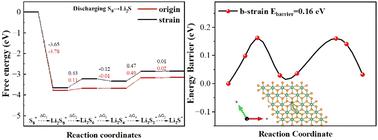当前位置:
X-MOL 学术
›
Phys. Chem. Chem. Phys.
›
论文详情
Our official English website, www.x-mol.net, welcomes your
feedback! (Note: you will need to create a separate account there.)
Uniaxial tensile strain impact on 1T-NbS2 monolayers as cathode material for lithium–sulfur batteries
Physical Chemistry Chemical Physics ( IF 2.9 ) Pub Date : 2024-11-12 , DOI: 10.1039/d4cp03156c Shanling Ren, Xiaocong Tan, Xin Huang, Zhihong Yang, Yunhui Wang
Physical Chemistry Chemical Physics ( IF 2.9 ) Pub Date : 2024-11-12 , DOI: 10.1039/d4cp03156c Shanling Ren, Xiaocong Tan, Xin Huang, Zhihong Yang, Yunhui Wang

|
The application of lithium–sulfur (Li–S) batteries as efficient energy storage systems is hindered by the polysulfide shuttle and expansion effects. To overcome these obstacles, we employed density functional theory (DFT) to explore the 1T-NbS2 monolayer as a cathode material for Li–S batteries, particularly focusing on the effects of uniaxial tensile strain. Our results indicate that the pristine 1T-NbS2 monolayer presents a balanced adsorption affinity for LiPSs, thereby mitigating the shuttle effect. The bond formation information is investigated through comprehensive analysis of charge transfer, physical/chemical adsorption, and projected crystal orbital Hamiltonian population (pCOHP). The projected density of states (PDOS) analysis reveals the role of sulfur atoms near the Fermi surface in the lithiation process. Notably, the system keeps superior metallic characteristics, alongside a diminished decomposition energy barrier (0.45 eV), lowered lithium-ion migration energy barrier (0.16 eV), and a diminished positive Gibbs free energy change (0.41 eV) during the sulfur reduction reaction (SSR). The imposition of uniaxial tensile strain on the 1T-NbS2 monolayer improves its adsorptive capacity for LiPSs and bolsters the retention of lithium–sulfur aggregates. These insights underscore the role of tensile strain in amplifying the efficiency of two-dimensional transition metal dichalcogenides as cathode materials of Li–S batteries.
中文翻译:

作为锂硫电池正极材料对 1T-NbS2 单层的单轴拉伸应变影响
锂硫 (Li-S) 电池作为高效储能系统的应用受到多硫化物穿梭和膨胀效应的阻碍。为了克服这些障碍,我们采用密度泛函理论 (DFT) 来探索 1T-NbS2 单层作为 Li-S 电池的正极材料,特别关注单轴拉伸应变的影响。我们的结果表明,原始的 1T-NbS2 单层对 LiPSs 表现出平衡的吸附亲和力,从而减轻了穿梭效应。通过对电荷转移、物理/化学吸附和投影晶体轨道哈密顿量 (pCOHP) 的综合分析来研究键形成信息。投影态密度 (PDOS) 分析揭示了费米表面附近的硫原子在锂化过程中的作用。值得注意的是,该系统在硫还原反应 (SSR) 期间保持了卓越的金属特性,同时分解能垒降低 (0.45 eV)、降低的锂离子迁移能垒 (0.16 eV) 和减少的正吉布斯自由能变化 (0.41 eV)。在 1T-NbS2 单层上施加单轴拉伸应变提高了其对 LiPSs 的吸附能力,并增强了锂硫聚集体的保留。这些见解强调了拉伸应变在放大二维过渡金属二硫化物作为 Li-S 电池正极材料的效率方面的作用。
更新日期:2024-11-12
中文翻译:

作为锂硫电池正极材料对 1T-NbS2 单层的单轴拉伸应变影响
锂硫 (Li-S) 电池作为高效储能系统的应用受到多硫化物穿梭和膨胀效应的阻碍。为了克服这些障碍,我们采用密度泛函理论 (DFT) 来探索 1T-NbS2 单层作为 Li-S 电池的正极材料,特别关注单轴拉伸应变的影响。我们的结果表明,原始的 1T-NbS2 单层对 LiPSs 表现出平衡的吸附亲和力,从而减轻了穿梭效应。通过对电荷转移、物理/化学吸附和投影晶体轨道哈密顿量 (pCOHP) 的综合分析来研究键形成信息。投影态密度 (PDOS) 分析揭示了费米表面附近的硫原子在锂化过程中的作用。值得注意的是,该系统在硫还原反应 (SSR) 期间保持了卓越的金属特性,同时分解能垒降低 (0.45 eV)、降低的锂离子迁移能垒 (0.16 eV) 和减少的正吉布斯自由能变化 (0.41 eV)。在 1T-NbS2 单层上施加单轴拉伸应变提高了其对 LiPSs 的吸附能力,并增强了锂硫聚集体的保留。这些见解强调了拉伸应变在放大二维过渡金属二硫化物作为 Li-S 电池正极材料的效率方面的作用。


















































 京公网安备 11010802027423号
京公网安备 11010802027423号